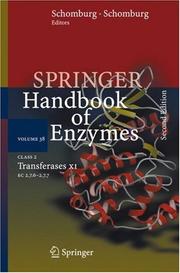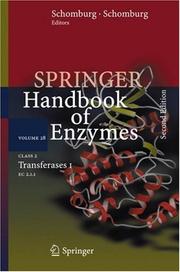| Listing 1 - 10 of 30 | << page >> |
Sort by
|

ISBN: 3540525793 0387525793 Year: 1990 Publisher: Berlin Springer
Abstract | Keywords | Export | Availability | Bookmark
 Loading...
Loading...Choose an application
- Reference Manager
- EndNote
- RefWorks (Direct export to RefWorks)
Enzymology --- Enzymes --- Lyases --- Handbooks, manuals, etc --- Guides, manuels, etc --- Banque de données --- Databases --- Nomenclature --- nomenclature --- Réaction chimique --- chemical reactions --- Structure chimique --- chemical structure --- Isolement --- Isolation --- #KVIV:BB --- $a577.15 --- EC-code enzymen --- Enzymen : biochemie --- nomenclature. --- Brenda --- Preparation --- Stabilite chimique

ISBN: 3540715266 3540715258 Year: 2007 Publisher: Berlin ; New York : Springer,
Abstract | Keywords | Export | Availability | Bookmark
 Loading...
Loading...Choose an application
- Reference Manager
- EndNote
- RefWorks (Direct export to RefWorks)
Springer Handbook of Enzymes provides data on enzymes sufficiently well characterized. It offers concise and complete descriptions of some 5,000 enzymes and their application areas. Data sheets are arranged in their EC-Number sequence and the volumes themselves are arranged according to enzyme classes. This new, second edition reflects considerable progress in enzymology: many enzymes are newly classified or reclassified. Each entry is correlated with references and one or more source organisms. New datafields are created: application and engineering (for the properties of enzymes where the sequence has been changed). The total amount of material contained in the Handbook has more than doubled so that the complete second edition consists of 39 volumes as well as a Synonym Index. In addition, starting in 2009, all newly classified enzymes are treated in Supplement Volumes. Springer Handbook of Enzymes is an ideal source of information for researchers in biochemistry, biotechnology, organic and analytical chemistry, and food sciences, as well as for medicinal applications.
Enzymes --- Enzymology. --- Biocatalysts --- Ferments --- Soluble ferments --- Catalysts --- Proteins --- Enzymology --- Biochemistry --- Enzymes. --- Biochemistry. --- Oncology. --- Toxicology. --- Biotechnology. --- Veterinary medicine. --- Biochemistry, general. --- Cancer Research. --- Pharmacology/Toxicology. --- Veterinary Medicine/Veterinary Science. --- Farriery --- Large animal medicine --- Large animal veterinary medicine --- Livestock medicine --- Veterinary science --- Medicine --- Animal health --- Animals --- Domestic animals --- Livestock --- Chemical engineering --- Genetic engineering --- Chemicals --- Pharmacology --- Poisoning --- Poisons --- Tumors --- Biological chemistry --- Chemical composition of organisms --- Organisms --- Physiological chemistry --- Biology --- Chemistry --- Medical sciences --- Diseases --- Losses --- Toxicology --- Composition --- Cancer research. --- Pharmacology. --- Drug effects --- Medical pharmacology --- Chemotherapy --- Drugs --- Pharmacy --- Cancer research --- Physiological effect

ISBN: 3540495347 3540325913 Year: 2006 Publisher: Berlin : Springer-Verlag,
Abstract | Keywords | Export | Availability | Bookmark
 Loading...
Loading...Choose an application
- Reference Manager
- EndNote
- RefWorks (Direct export to RefWorks)
Springer Handbook of Enzymes provides data on enzymes sufficiently well characterized. It offers concise and complete descriptions of some 5,000 enzymes and their application areas. Data sheets are arranged in their EC-Number sequence and the volumes themselves are arranged according to enzyme classes. This new, second edition reflects considerable progress in enzymology: many enzymes are newly classified or reclassified. Each entry is correlated with references and one or more source organisms. New datafields are created: application and engineering (for the properties of enzymes where the sequence has been changed). The total amount of material contained in the Handbook has more than doubled so that the complete second edition consists of 39 volumes as well as a Synonym Index. In addition, starting in 2009, all newly classified enzymes are treated in Supplement Volumes. Springer Handbook of Enzymes is an ideal source of information for researchers in biochemistry, biotechnology, organic and analytical chemistry, and food sciences, as well as for medicinal applications.
Enzymes --- Transferases. --- Biocatalysts --- Ferments --- Soluble ferments --- Catalysts --- Proteins --- Enzymology --- Enzymes. --- Biochemistry. --- Oncology. --- Toxicology. --- Biotechnology. --- Veterinary medicine. --- Enzymology. --- Biochemistry, general. --- Cancer Research. --- Pharmacology/Toxicology. --- Veterinary Medicine/Veterinary Science. --- Farriery --- Large animal medicine --- Large animal veterinary medicine --- Livestock medicine --- Veterinary science --- Medicine --- Animal health --- Animals --- Domestic animals --- Livestock --- Chemical engineering --- Genetic engineering --- Chemicals --- Pharmacology --- Poisoning --- Poisons --- Tumors --- Biological chemistry --- Chemical composition of organisms --- Organisms --- Physiological chemistry --- Biology --- Chemistry --- Medical sciences --- Diseases --- Losses --- Toxicology --- Composition --- Cancer research. --- Pharmacology. --- Drug effects --- Medical pharmacology --- Chemotherapy --- Drugs --- Pharmacy --- Cancer research --- Biochemistry --- Physiological effect

ISBN: 3540377158 3540319174 Year: 2006 Publisher: Berlin, Heidelberg : Springer-Verlag Berlin Heidelberg,
Abstract | Keywords | Export | Availability | Bookmark
 Loading...
Loading...Choose an application
- Reference Manager
- EndNote
- RefWorks (Direct export to RefWorks)
Springer Handbook of Enzymes provides data on enzymes sufficiently well characterized. It offers concise and complete descriptions of some 5,000 enzymes and their application areas. Data sheets are arranged in their EC-Number sequence and the volumes themselves are arranged according to enzyme classes. This new, second edition reflects considerable progress in enzymology: many enzymes are newly classified or reclassified. Each entry is correlated with references and one or more source organisms. New datafields are created: application and engineering (for the properties of enzymes where the sequence has been changed). The total amount of material contained in the Handbook has more than doubled so that the complete second edition consists of 39 volumes as well as a Synonym Index. In addition, starting in 2009, all newly classified enzymes are treated in Supplement Volumes. Springer Handbook of Enzymes is an ideal source of information for researchers in biochemistry, biotechnology, organic and analytical chemistry, and food sciences, as well as for medicinal applications.
Enzymes --- Transferases. --- Biocatalysts --- Ferments --- Soluble ferments --- Catalysts --- Proteins --- Enzymology

ISBN: 3540478183 3540478167 Year: 2007 Publisher: Heidelberg : Springer,
Abstract | Keywords | Export | Availability | Bookmark
 Loading...
Loading...Choose an application
- Reference Manager
- EndNote
- RefWorks (Direct export to RefWorks)
Springer Handbook of Enzymes provides data on enzymes sufficiently well characterized. It offers concise and complete descriptions of some 5,000 enzymes and their application areas. Data sheets are arranged in their EC-Number sequence and the volumes themselves are arranged according to enzyme classes. This new, second edition reflects considerable progress in enzymology: many enzymes are newly classified or reclassified. Each entry is correlated with references and one or more source organisms. New datafields are created: application and engineering (for the properties of enzymes where the sequence has been changed). The total amount of material contained in the Handbook has more than doubled so that the complete second edition consists of 39 volumes as well as a Synonym Index. In addition, starting in 2009, all newly classified enzymes are treated in Supplement Volumes. Springer Handbook of Enzymes is an ideal source of information for researchers in biochemistry, biotechnology, organic and analytical chemistry, and food sciences, as well as for medicinal applications.
Enzymes --- Enzymology. --- Biochemistry --- Biocatalysts --- Ferments --- Soluble ferments --- Catalysts --- Proteins --- Enzymology --- Enzymes. --- Biochemistry. --- Oncology. --- Toxicology. --- Biotechnology. --- Veterinary medicine. --- Biochemistry, general. --- Cancer Research. --- Pharmacology/Toxicology. --- Veterinary Medicine/Veterinary Science. --- Farriery --- Large animal medicine --- Large animal veterinary medicine --- Livestock medicine --- Veterinary science --- Medicine --- Animal health --- Animals --- Domestic animals --- Livestock --- Chemical engineering --- Genetic engineering --- Chemicals --- Pharmacology --- Poisoning --- Poisons --- Tumors --- Biological chemistry --- Chemical composition of organisms --- Organisms --- Physiological chemistry --- Biology --- Chemistry --- Medical sciences --- Diseases --- Losses --- Toxicology --- Composition --- Cancer research. --- Pharmacology. --- Drug effects --- Medical pharmacology --- Chemotherapy --- Drugs --- Pharmacy --- Cancer research --- Physiological effect

ISBN: 3540365095 3642431763 3540497552 Year: 2006 Publisher: Berlin : Springer,
Abstract | Keywords | Export | Availability | Bookmark
 Loading...
Loading...Choose an application
- Reference Manager
- EndNote
- RefWorks (Direct export to RefWorks)
Springer Handbook of Enzymes provides data on enzymes sufficiently well characterized. It offers concise and complete descriptions of some 5,000 enzymes and their application areas. Data sheets are arranged in their EC-Number sequence and the volumes themselves are arranged according to enzyme classes. This new, second edition reflects considerable progress in enzymology: many enzymes are newly classified or reclassified. Each entry is correlated with references and one or more source organisms. New datafields are created: application and engineering (for the properties of enzymes where the sequence has been changed). The total amount of material contained in the Handbook has more than doubled so that the complete second edition consists of 39 volumes as well as a Synonym Index. In addition, starting in 2009, all newly classified enzymes are treated in Supplement Volumes. Springer Handbook of Enzymes is an ideal source of information for researchers in biochemistry, biotechnology, organic and analytical chemistry, and food sciences, as well as for medicinal applications.
Life sciences. --- Cancer research. --- Pharmacology. --- Biotechnology. --- Veterinary medicine. --- Biochemistry. --- Enzymology. --- Life Sciences. --- Biochemistry, general. --- Cancer Research. --- Pharmacology/Toxicology. --- Veterinary Medicine. --- Biochemistry --- Enzymes --- Biological chemistry --- Chemical composition of organisms --- Organisms --- Physiological chemistry --- Biology --- Chemistry --- Medical sciences --- Farriery --- Large animal medicine --- Large animal veterinary medicine --- Livestock medicine --- Veterinary science --- Medicine --- Animal health --- Animals --- Domestic animals --- Livestock --- Chemical engineering --- Genetic engineering --- Drug effects --- Medical pharmacology --- Chemicals --- Chemotherapy --- Drugs --- Pharmacy --- Cancer research --- Biosciences --- Sciences, Life --- Science --- Composition --- Diseases --- Losses --- Physiological effect --- Enzymes. --- Oncology. --- Toxicology. --- Veterinary Medicine/Veterinary Science. --- Pharmacology --- Poisoning --- Poisons --- Tumors --- Biocatalysts --- Ferments --- Soluble ferments --- Catalysts --- Proteins --- Enzymology --- Toxicology --- Transferases.
Book
ISBN: 354071524X 3540715231 Year: 2008 Publisher: Berlin ; New York : Springer,
Abstract | Keywords | Export | Availability | Bookmark
 Loading...
Loading...Choose an application
- Reference Manager
- EndNote
- RefWorks (Direct export to RefWorks)
Springer Handbook of Enzymes provides data on enzymes sufficiently well characterized. It offers concise and complete descriptions of some 5,000 enzymes and their application areas. Data sheets are arranged in their EC-Number sequence and the volumes themselves are arranged according to enzyme classes. This new, second edition reflects considerable progress in enzymology: many enzymes are newly classified or reclassified. Each entry is correlated with references and one or more source organisms. New datafields are created: application and engineering (for the properties of enzymes where the sequence has been changed). The total amount of material contained in the Handbook has more than doubled so that the complete second edition consists of 39 volumes as well as a Synonym Index. In addition, starting in 2009, all newly classified enzymes are treated in Supplement Volumes. Springer Handbook of Enzymes is an ideal source of information for researchers in biochemistry, biotechnology, organic and analytical chemistry, and food sciences, as well as for medicinal applications.
Enzymes --- Biocatalysts --- Ferments --- Soluble ferments --- Catalysts --- Proteins --- Enzymology --- Enzymes. --- Biochemistry. --- Oncology. --- Toxicology. --- Biotechnology. --- Veterinary medicine. --- Enzymology. --- Biochemistry, general. --- Cancer Research. --- Pharmacology/Toxicology. --- Veterinary Medicine/Veterinary Science. --- Biological chemistry --- Chemical composition of organisms --- Organisms --- Physiological chemistry --- Biology --- Chemistry --- Medical sciences --- Farriery --- Large animal medicine --- Large animal veterinary medicine --- Livestock medicine --- Veterinary science --- Medicine --- Animal health --- Animals --- Domestic animals --- Livestock --- Chemical engineering --- Genetic engineering --- Chemicals --- Pharmacology --- Poisoning --- Poisons --- Tumors --- Composition --- Diseases --- Losses --- Toxicology --- Cancer research. --- Pharmacology. --- Drug effects --- Medical pharmacology --- Chemotherapy --- Drugs --- Pharmacy --- Cancer research --- Biochemistry --- Physiological effect
Book
ISBN: 3642362591 3642362605 3642437923 Year: 2013 Publisher: Berlin ; New York : Springer,
Abstract | Keywords | Export | Availability | Bookmark
 Loading...
Loading...Choose an application
- Reference Manager
- EndNote
- RefWorks (Direct export to RefWorks)
Springer Handbook of Enzymes provides data on enzymes sufficiently well characterized. It offers concise and complete descriptions of some 5,000 enzymes and their application areas. Data sheets are arranged in their EC-Number sequence and the volumes themselves are arranged according to enzyme classes. This new, second edition reflects considerable progress in enzymology: many enzymes are newly classified or reclassified. Each entry is correlated with references and one or more source organisms. New datafields are created: application and engineering (for the properties of enzymes where the sequence has been changed). The total amount of material contained in the Handbook has more than doubled so that the complete second edition consists of 39 volumes as well as a Synonym Index. In addition, starting in 2009, all newly classified enzymes are treated in Supplement Volumes. Springer Handbook of Enzymes is an ideal source of information for researchers in biochemistry, biotechnology, organic and analytical chemistry, and food sciences, as well as for medicinal applications.
Chemistry --- Biology --- Physical Sciences & Mathematics --- Health & Biological Sciences --- Biology - General --- Biochemistry --- Enzymes --- Hydrolases. --- Lyases. --- Isomerases. --- Ligases. --- Synthetases --- Isomerase --- Desmolases --- Hydrolytic enzymes --- Biocatalysts --- Ferments --- Soluble ferments --- Life sciences. --- Molecular biology. --- Pharmacology. --- Biotechnology. --- Food --- Veterinary medicine. --- Biochemistry. --- Life Sciences. --- Biochemistry, general. --- Molecular Medicine. --- Pharmacology/Toxicology. --- Food Science. --- Veterinary Medicine. --- Catalysts --- Proteins --- Enzymology --- Medicine. --- Toxicology. --- Food science. --- Veterinary Medicine/Veterinary Science. --- Farriery --- Large animal medicine --- Large animal veterinary medicine --- Livestock medicine --- Veterinary science --- Medicine --- Animal health --- Animals --- Domestic animals --- Livestock --- Chemical engineering --- Genetic engineering --- Science --- Chemicals --- Pharmacology --- Poisoning --- Poisons --- Clinical sciences --- Medical profession --- Human biology --- Life sciences --- Medical sciences --- Pathology --- Physicians --- Biological chemistry --- Chemical composition of organisms --- Organisms --- Physiological chemistry --- Diseases --- Losses --- Toxicology --- Composition --- Health Workforce --- Food—Biotechnology. --- Drug effects --- Medical pharmacology --- Chemotherapy --- Drugs --- Pharmacy --- Molecular biochemistry --- Molecular biophysics --- Biophysics --- Biomolecules --- Systems biology --- Physiological effect
Book
ISBN: 3540857044 3540857052 Year: 2009 Publisher: New York ; Berlin ; London : Springer,
Abstract | Keywords | Export | Availability | Bookmark
 Loading...
Loading...Choose an application
- Reference Manager
- EndNote
- RefWorks (Direct export to RefWorks)
Springer Handbook of Enzymes provides data on enzymes sufficiently well characterized. It offers concise and complete descriptions of some 5,000 enzymes and their application areas. Data sheets are arranged in their EC-Number sequence and the volumes themselves are arranged according to enzyme classes. This new, second edition reflects considerable progress in enzymology: many enzymes are newly classified or reclassified. Each entry is correlated with references and one or more source organisms. New datafields are created: application and engineering (for the properties of enzymes where the sequence has been changed). The total amount of material contained in the Handbook has more than doubled so that the complete second edition consists of 39 volumes as well as a Synonym Index. In addition, starting in 2009, all newly classified enzymes are treated in Supplement Volumes. Springer Handbook of Enzymes is an ideal source of information for researchers in biochemistry, biotechnology, organic and analytical chemistry, and food sciences, as well as for medicinal applications.
Enzymes -- Handbooks, manuals, etc. --- Biochemistry --- Biology - General --- Animal Biochemistry --- Biology --- Chemistry --- Human Anatomy & Physiology --- Health & Biological Sciences --- Physical Sciences & Mathematics --- Enzymes --- Hydrolases --- Hydrolytic enzymes --- Biocatalysts --- Ferments --- Soluble ferments --- Life sciences. --- Human physiology. --- Molecular biology. --- Pharmacology. --- Food --- Biochemistry. --- Enzymology. --- Life Sciences. --- Human Physiology. --- Pharmacology/Toxicology. --- Biochemistry, general. --- Molecular Medicine. --- Food Science. --- Biotechnology. --- Catalysts --- Proteins --- Enzymology --- Enzymes. --- Toxicology. --- Medicine. --- Food science. --- Science --- Clinical sciences --- Medical profession --- Human biology --- Life sciences --- Medical sciences --- Pathology --- Physicians --- Biological chemistry --- Chemical composition of organisms --- Organisms --- Physiological chemistry --- Chemicals --- Medicine --- Pharmacology --- Poisoning --- Poisons --- Physiology --- Human body --- Composition --- Toxicology --- Health Workforce --- Food—Biotechnology. --- Molecular biochemistry --- Molecular biophysics --- Biophysics --- Biomolecules --- Systems biology --- Drug effects --- Medical pharmacology --- Chemotherapy --- Drugs --- Pharmacy --- Physiological effect
Book
ISBN: 3540851879 3540851887 Year: 2009 Publisher: Berlin ; London : Springer,
Abstract | Keywords | Export | Availability | Bookmark
 Loading...
Loading...Choose an application
- Reference Manager
- EndNote
- RefWorks (Direct export to RefWorks)
Springer Handbook of Enzymes provides data on enzymes sufficiently well characterized. It offers concise and complete descriptions of some 5,000 enzymes and their application areas. Data sheets are arranged in their EC-Number sequence and the volumes themselves are arranged according to enzyme classes. This new, second edition reflects considerable progress in enzymology: many enzymes are newly classified or reclassified. Each entry is correlated with references and one or more source organisms. New datafields are created: application and engineering (for the properties of enzymes where the sequence has been changed). The total amount of material contained in the Handbook has more than doubled so that the complete second edition consists of 39 volumes as well as a Synonym Index. In addition, starting in 2009, all newly classified enzymes are treated in Supplement Volumes. Springer Handbook of Enzymes is an ideal source of information for researchers in biochemistry, biotechnology, organic and analytical chemistry, and food sciences, as well as for medicinal applications.
Enzymes -- Handbooks, manuals, etc. --- Biology - General --- Biochemistry --- Biology --- Chemistry --- Physical Sciences & Mathematics --- Health & Biological Sciences --- Enzymes --- Physiology. --- Animal physiology --- Animals --- Biocatalysts --- Ferments --- Soluble ferments --- Physiology --- Life sciences. --- Molecular biology. --- Pharmacology. --- Biotechnology. --- Food --- Biochemistry. --- Enzymology. --- Life Sciences. --- Biochemistry, general. --- Molecular Medicine. --- Pharmacology/Toxicology. --- Food Science. --- Catalysts --- Proteins --- Enzymology --- Anatomy --- Enzymes. --- Medicine. --- Toxicology. --- Food science. --- Chemical engineering --- Genetic engineering --- Science --- Chemicals --- Medicine --- Pharmacology --- Poisoning --- Poisons --- Clinical sciences --- Medical profession --- Human biology --- Life sciences --- Medical sciences --- Pathology --- Physicians --- Biological chemistry --- Chemical composition of organisms --- Organisms --- Physiological chemistry --- Toxicology --- Composition --- Health Workforce --- Food—Biotechnology. --- Drug effects --- Medical pharmacology --- Chemotherapy --- Drugs --- Pharmacy --- Molecular biochemistry --- Molecular biophysics --- Biophysics --- Biomolecules --- Systems biology --- Physiological effect
| Listing 1 - 10 of 30 | << page >> |
Sort by
|

 Search
Search Feedback
Feedback About UniCat
About UniCat  Help
Help News
News